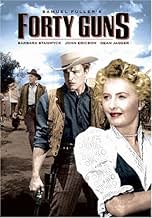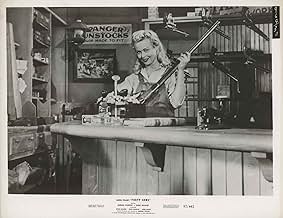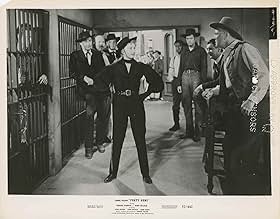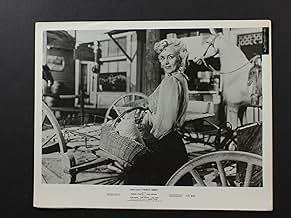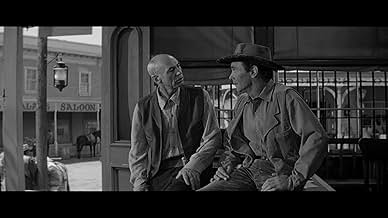PUNTUACIÓN EN IMDb
7,0/10
6,6 mil
TU PUNTUACIÓN
Añade un argumento en tu idiomaShowdown in Arizona between the Bonnell brothers, U.S.Marshals, and Jessica Drummond, the iron-fist rancher who controls the territory.Showdown in Arizona between the Bonnell brothers, U.S.Marshals, and Jessica Drummond, the iron-fist rancher who controls the territory.Showdown in Arizona between the Bonnell brothers, U.S.Marshals, and Jessica Drummond, the iron-fist rancher who controls the territory.
Sandy Wirth
- Chico's Girlfriend
- (as Sandra Wirth)
Albert Cavens
- Doctor
- (sin acreditar)
Tex Driscoll
- Barber
- (sin acreditar)
Argumento
¿Sabías que...?
- CuriosidadesBarbara Stanwyck's stunt woman refused to be dragged by a horse, saying that it was too dangerous. Without further ado, Stanwyck did it by herself. She got some bruises and scrapes, but was okay. At that time, she was 49 years old.
- PifiasWhen the gunsmith is fitting Wes for a new rifle, he is holding the stock from a model 1898 Mauser, which would not be invented for another 20 years. Wes also picks up a Winchester and looks through the barrel to see the lady gunsmith, which is not possible due to there being no straight line of sight through the action.
- Citas
Jessica Drummond: I'm not interested in *you*, Mr. Bonnell. It's your trademark.
[gestures at his gun, purring]
Jessica Drummond: May I feel it?
Griff Bonnell: Uh-uh.
Jessica Drummond: Just curious.
Griff Bonnell: It might go off in your face.
Jessica Drummond: I'll take a chance.
- ConexionesEdited into Gli ultimi giorni dell'umanità (2022)
Reseña destacada
Forty Guns (1957)
Sam Fuller's style is uncompromising and over the top. He pushes both melodrama and visual drama. And he's also extremely astute handling the actors and the space and light they move through. His movies are definitely experiences, from "The Naked Kiss" to "The Big Red One" all the way back to the masterpiece, "Pickup on South Street."
And he usually tells a strong clear story. That's the big weakness here. It's as if all the over-sized elements, including Barbara Stanwyck as this unlikely woman power queen frontier figure with forty men at her beck and call, are juggled around enough to keep it interesting just on their own. Not only will the progress of events be sometimes confusing, it will at times also be too unlikely to hold water, which is even worse.
Not that the movie isn't a thrill to watch. I mean watch, with your eyes. The sparkling widescreen photography is so good, so very good and original, you can't help but like that part of it. In a way that's sustaining--it's what kept me glued. But that's my thing. I'm a photographer. I love the physical structure of movies. This movie was made for me. It's made to be studied.
And that's what "Forty Guns" is famous for, an over-sized influence. The French writers of the time (like Godard) and some later American upstarts (like Tarantino) have praised the filmmaking, if not always the film. You can certainly see, and appreciate, how much a movie like this foreshadowed the spaghetti westerns which have become so famous, but which were made six and more years later.
And that's worth remembering, too. Westerns, as a genre, are well worn by now. The themes have been worked and overworked. To make a new fresh western means pushing it to some limit, and for Fuller that means a soap opera exaggeration. That means galloping horses endlessly around a waiting stagecoach as the horses jump in fear. That means a man walking up to his rival and walking and walking, far longer than it would take to cover the hundred yards shown, until reaching him and punching, not shooting him. It means a final glorious scene that is shown farther and farther in the distance and all you see are two little dots as figures--and yet you know what just happened, and how satisfying that is.
And how unreasonable the events were getting us to that point. "Forty Guns" plays loose with archetypes in a pre-post-modern way that has made it weirdly contemporary. Fuller's films, like his unlikely contemporary Douglas Sirk's, have taken on a life of their own, as flawed as they are. This may not be the best place to start to love his work, but it's a good place to start to understand where movies had gotten to--some would say fallen--by the late 1950s. Check it out.
Sam Fuller's style is uncompromising and over the top. He pushes both melodrama and visual drama. And he's also extremely astute handling the actors and the space and light they move through. His movies are definitely experiences, from "The Naked Kiss" to "The Big Red One" all the way back to the masterpiece, "Pickup on South Street."
And he usually tells a strong clear story. That's the big weakness here. It's as if all the over-sized elements, including Barbara Stanwyck as this unlikely woman power queen frontier figure with forty men at her beck and call, are juggled around enough to keep it interesting just on their own. Not only will the progress of events be sometimes confusing, it will at times also be too unlikely to hold water, which is even worse.
Not that the movie isn't a thrill to watch. I mean watch, with your eyes. The sparkling widescreen photography is so good, so very good and original, you can't help but like that part of it. In a way that's sustaining--it's what kept me glued. But that's my thing. I'm a photographer. I love the physical structure of movies. This movie was made for me. It's made to be studied.
And that's what "Forty Guns" is famous for, an over-sized influence. The French writers of the time (like Godard) and some later American upstarts (like Tarantino) have praised the filmmaking, if not always the film. You can certainly see, and appreciate, how much a movie like this foreshadowed the spaghetti westerns which have become so famous, but which were made six and more years later.
And that's worth remembering, too. Westerns, as a genre, are well worn by now. The themes have been worked and overworked. To make a new fresh western means pushing it to some limit, and for Fuller that means a soap opera exaggeration. That means galloping horses endlessly around a waiting stagecoach as the horses jump in fear. That means a man walking up to his rival and walking and walking, far longer than it would take to cover the hundred yards shown, until reaching him and punching, not shooting him. It means a final glorious scene that is shown farther and farther in the distance and all you see are two little dots as figures--and yet you know what just happened, and how satisfying that is.
And how unreasonable the events were getting us to that point. "Forty Guns" plays loose with archetypes in a pre-post-modern way that has made it weirdly contemporary. Fuller's films, like his unlikely contemporary Douglas Sirk's, have taken on a life of their own, as flawed as they are. This may not be the best place to start to love his work, but it's a good place to start to understand where movies had gotten to--some would say fallen--by the late 1950s. Check it out.
- secondtake
- 26 dic 2012
- Enlace permanente
Selecciones populares
Inicia sesión para calificar y añadir a tu lista para recibir recomendaciones personalizadas
- How long is Forty Guns?Con tecnología de Alexa
Detalles
- Fecha de lanzamiento
- País de origen
- Idioma
- Títulos en diferentes países
- Quaranta pistoles
- Localizaciones del rodaje
- Empresas productoras
- Ver más compañías en los créditos en IMDbPro
Taquilla
- Presupuesto
- 300.000 US$ (estimación)
- Recaudación en todo el mundo
- 6344 US$
- Duración1 hora 20 minutos
- Color
- Relación de aspecto
- 2.35 : 1
Contribuir a esta página
Sugerir un cambio o añadir el contenido que falta

Principal laguna de datos
By what name was Cuarenta pistolas (1957) officially released in India in English?
Responde

